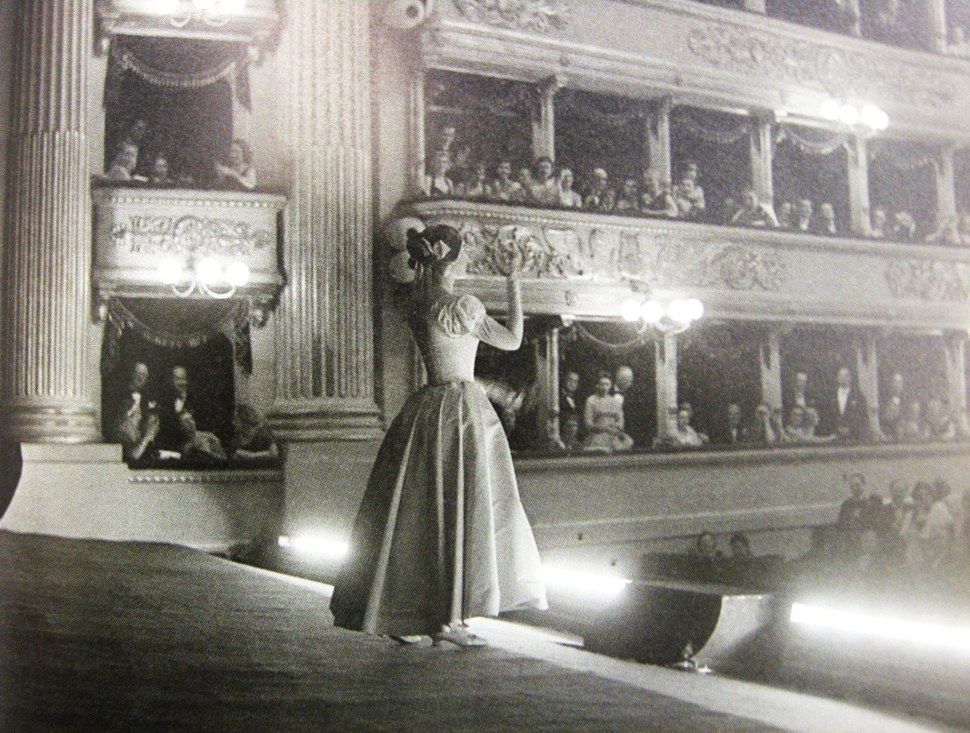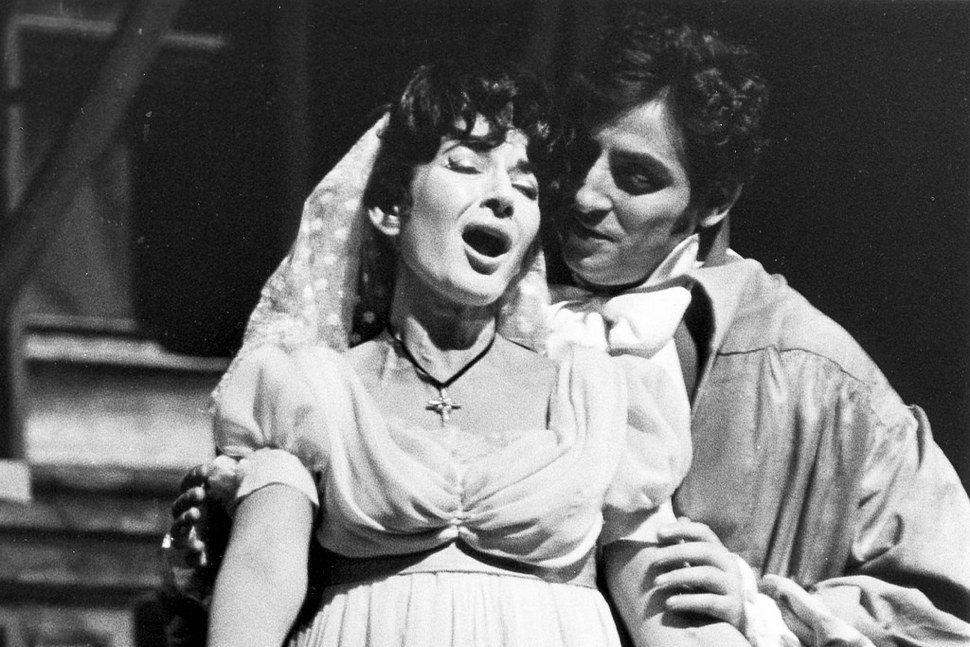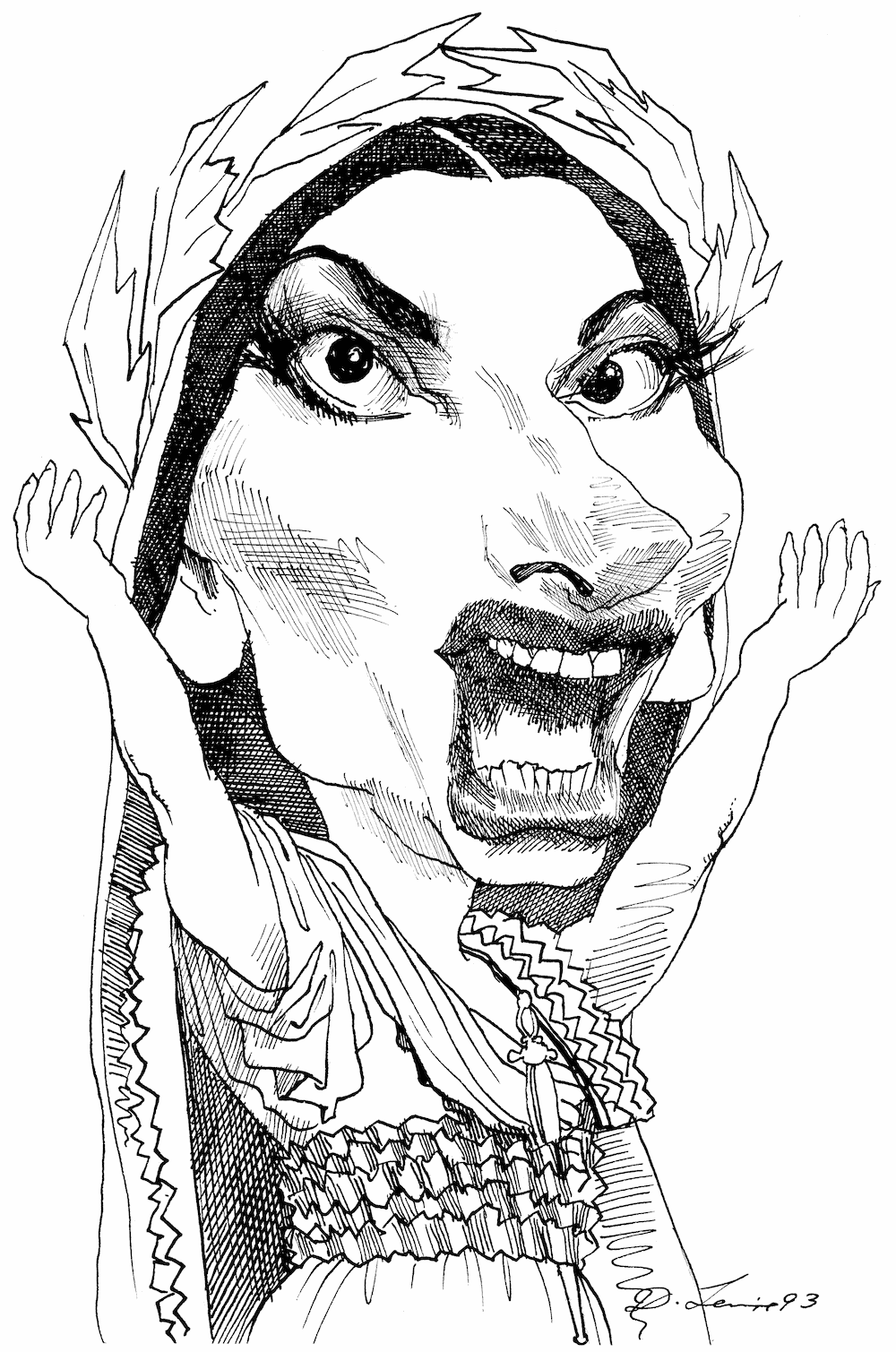Maria Callas converted me to opera. I am sure I am not unique in this, except in the particulars. In my early college years I immersed myself in recordings of the nineteenth-century symphonic repertory—Beethoven, Schubert, Brahms, Bruckner, the Russians—but for a long time I refused to listen to opera, would listen to an overture and then rush to change the record before the singing started. Then one day my roommate put Callas’s 1953 Tosca on the turntable and dropped the needle onto “Vissi d’arte.” I had no idea what she was singing, but near the conclusion of that imploring aria, as she comes to the end of the arching wordless phrase that soars from an A down slightly to a G, there is an audible intake of breath. She gasps—or is it a sob?
Maybe she misjudged her breathing, but I can no more assess it in such terms now than I could then. It sounded—it still sounds—to me like pure emotion. I didn’t need to know, at that moment, that Tosca was asking God why, despite all her devotion to art, to the Virgin, she was being forced to submit to the advances of the Roman police chief in order to save her lover from execution. That gasp—not even a note; maybe the least musical thing in the entire opera—opened up a world to me: a world of feeling pushed to an extreme, an operatic world, that in large measure became defined for me by Callas.
I tell this story at some risk to my point. Yet if I hadn’t been hooked by a gasp, I would eventually have been hooked by her way with something else—a word, a phrase, an aria, a scene. For what made Callas a great singer was her fierce commitment to the voice as a means of dramatic expression. This must be stressed: her fame as an artist came not from gossip about her temper or her cancellations or her relationship with Aristotle Onassis. She was not great because of her “acting,” some riveting physical gestures and electrifying stage presence that we must trust those who actually saw her to verify. If that was primarily what she brought to her performances, she would be a dim legend by now. (The few extant videos of her—mostly in recital—suggest rather how inward her identification with her characters was, how restrained her gestures onstage must have been.)
It is the other way around: Callas was a great actress because she was a great musician, because she understood that for a singer the drama is above all in the voice—in phrasing, in shaping the vocal line, in executing a perfect descending scale, in giving every word—even, or especially, in recitatives—its proper emphasis. Nothing is passed over, nothing ignored or slighted. (Listen, for example, to the monastery scene from La Forza del Destino: you hear Leonora’s desperation, that her very chance at salvation is at stake.) It is Callas’s voice that is riveting: instantly recognizable, intensely focused, it is theater; it is why, nearly forty years after her death, nearly fifty after her last stage performance, her recordings have never gone out of print but constantly find new admirers.
Before her first performances of Leonora in Verdi’s Il Trovatore in 1950, Callas’s mentor, the conductor Tullio Serafin, refused to help her learn the role for another conductor. So she “plunged into the score…absorbing every note and expression mark,” writes John Ardoin in The Callas Legacy, with the result that “the wealth of detail her voice unearths here is breathtaking. It is as if an old painting, familiar but dim, has been cleaned to its original tints.”
The same could be said of Callas Remastered, the new edition of all of her studio recordings—twenty-six operas and thirteen recital discs, the earliest from 1949, the last from 1969. Performances long familiar from LPs or the two earlier, less careful CD transfers now leap from the speakers with vivid clarity of sound. Engineers at Warner Classics (which acquired EMI, the company that produced most of them, in 2013) went back to the original master tapes and production notes from the recording sessions to create what finally must be, at least until the next advance in the technology of sound reproduction, the definitive digital version. (The book included in the complete set gives a detailed account of the process.)
You can hear the difference that the new remastering has made, for example, in the beginning of the “Casta Diva” from Bellini’s Norma, recorded (in stereo) in 1960. It was the role she sang more than any other—nearly ninety times between 1948 and 1965. Its demands are not only vocal, from coloratura to martial declamation, but emotional, from mystical reverie to fury to interior monologue to supplication. Over almost twenty years, Callas developed for it her most penetrating dramatic insights; this most complete character became her most complete characterization, meticulously differentiating the priestess, the mother, the warrior, the anxious then raging then reconciled mistress.
Advertisement
Callas Remastered, by bringing us as close as we can come to what she must have sounded like, at least in the studio, is an opportunity to rediscover what made her such a sensation. In her prime her voice had a range of nearly three octaves and a very particular timbre; it was moreover able to negotiate elaborate vocal lines with precision, power, and a variety of tonal shading. She simply sounded like no one else. One Italian critic described her as “a star wandering into a planetary system not its own.” But her voice had more than technical facility. It was also uncommonly expressive: it was what Leo Lerman called “the most haunting voice I have ever heard…filled with lost joys, permeated with present despairs.” It was, to be sure, a voice that was not conventionally beautiful. From the beginning it could be uneven; as Ardoin writes, it “divided into three distinct registers: a bottled, covered low voice; a reedy middle and a top that was brilliant at times to the point of stridency and that would, without warning, threaten to wobble out of control.” Over the two decades represented in this collection she underwent a marked vocal decline; by the 1960s the wobble had become more pronounced, and the tone could turn raw.
It is sobering to recall how short a career Callas had. Though she began singing while a conservatory student in Athens just before World War II, her professional stage career began in 1947, when she was twenty-three. In her early years she was cast primarily in Wagnerian and verismo roles like La Gioconda, Isolde, and Turandot that required a voice powerful enough to soar over a large orchestra. Then in 1949, in Venice, where she was singing Brünnhilde in Die Walküre, she substituted on short notice for an ailing soprano as Elvira in Bellini’s I Puritani, a role that requires a completely different kind of voice, one with vocal agility in coloratura passages and the ability to sustain long melodic lines suffused with pathos.
A Brünnhilde might have sung Norma, but not Elvira. Yet it was a more than a virtuosoic stunt: it was a relevation. Callas, by fusing the weight and color of her dramatic soprano voice with the nineteenth-century bel canto technique she had absorbed as a student, rediscovered the emotional depths in roles that had long been performed, if they were performed at all, by light-voiced sopranos as pretexts for mindless vocal display. When she sang Lucia di Lammermoor, Violetta in La Traviata, Anna Bolena, or Imogene in Il Pirata, they once again became fully dimensional tragic figures. It was the beginning of the revitalization of an entire genre: in the following decades operas by Bellini, Donizetti, and Rossini that had fallen out of favor over the previous century were pulled from dusty archives and became vehicles for Leyla Gencer, Joan Sutherland, Montserrat Caballe, and Beverly Sills, among others. Many of them had superb voices; hardly any could approach Callas’s gift for seizing the dramatic possibilities in such works.
For a few magical years in the 1950s she seemed unconstrained by conventional vocal categories, able to adapt her voice equally to the wistful tones of Anina in Bellini’s La Sonnambula and the menacing ones of Verdi’s Lady Macbeth. But her conquests of such a wide range of roles came at a cost. Her vocal flaws became harder and harder to control. She gave her last performance of a complete opera in 1965, but by then her singing had been unreliable for a half-dozen years. (The best account of her decline is by Will Crutchfield). Her greatest accomplishments were packed into barely more than a decade.
Callas was fortunate that her emergence coincided with the introduction of the long-playing record in 1948, which meant that recording companies were keen to build their catalogs. She began recording for the Italian label Cetra in 1949, with an album of arias, followed by complete recordings of La Traviata and La Gioconda (all of which are included in the newly remastered set). By 1953 she had been lured to the much bigger EMI, for which she recorded until 1969, and which enabled her to reach a much wider audience across Europe and the US. That first Cetra recital, with Isolde’s Liebestod, the “Casta Diva,” as well as Elvira’s mad scene from I Puritani, already displays her extraordinary range.
Advertisement
Callas Remastered does not, of course, give us Callas whole: there are also many recordings of live performances from opera houses and concert stages, beginning in 1949, that preserve important roles that she never recorded in full in the studio, such as Abigaille in Nabucco, Lady Macbeth, and Anna Bolena; in some cases where both exist, the live recordings capture her in better voice or more dramatically engaged. Her best Norma, for example, is neither of the studio versions but the live performance from La Scala’s opening night in 1955—widely available on CD—that caught her in dazzlingly secure voice.
But I found myself, almost morbidly, listening over and over to what has often been considered the least successful of her recordings, the second, stereo Lucia of 1959—one of the very few I had never heard until I got the new set. It has been much criticized, by John Ardoin, among others, as failing to match her previous recording of the role. So it comes as some surprise to read, in the book accompanying Callas Remastered, her producer Walter Legge’s comments about it: “Unless I am very much mistaken it will be a sensational success. Callas has never sung so well…”
One imagines that Legge must have been reassuring the executives at EMI, for the performance lacks the fearless brilliance of her 1953 studio recording (in mono) of the role. It lacks the plaintive despair of the live performance from Berlin in 1955, in which the notes veering in and out of control in the mad scene seem to purposefully reflect Lucia’s unhinged mind. Where once the fragility of the voice seemed calculated to convey the fragility of the character, it is now too easy to hear the character’s fragility as the singer’s. Some high notes waver uncomfortably, there are unaccustomed compromises in some of the more difficult passages, and the supporting cast sounds more provincial than in her previous Lucias.
So one wonders, in hindsight, why this was a priority for EMI at the time. Yes, the sound is “better,” but the singing isn’t. Did the advent of stereo recordings in 1958 really mean that it was better to replace the splendid earlier mono Lucia than to have Callas set down before the microphones any number of her other important roles that she hadn’t recorded? Why a new Lucia and not Macbeth or Anna Bolena, in both of which she triumphed at La Scala but of which she only recorded excerpts? Such inscrutable commercial decisions haunt her entire recording career. Why record Manon Lescaut and La Boheme—roles she never sang onstage—instead of I Vespri Siciliani or Il Pirata, which she did? Presumably EMI’s assessment of the market dictated giving priority to better-known works even if she had no association with them. Perhaps no one expected her career to be so brief, even as she was performing less and less frequently and less and less consistently well.
It is important to resist living entirely in a golden operatic past accessible only through recordings. Opera requires the excitement and uncertainty of live performance, of new singers who can bring their own unexpected insights to their characters. But there is equally no reason to forget history—the standards set by the great singers of the past. Callas wasn’t perfect, to be sure. (And perfect can be boring, as some of her successors have demonstrated.) But she was something more: even when she falls short of her best, she gives an intimation of what an ideal performance might sound like. Few more perfect singers have managed to do that.
I have lingered here too much over doubts, but better to end without equivocation, with a final example of Callas’s sovereign self-assurance: I Vespri Siciliani, in which she made her debut at La Scala in 1951. We can hear her in a dimly taped production of the opera in Florence earlier that year, the highlight of which is her gripping, surreptitious first-act call to arms, which she unfortunately never recorded in the studio. While for EMI she returned several times in the 1960s to Elena’s fourth-act aria, she recorded the florid fifth-act Bolero only once, in 1954 for the album Lyric and Coloratura Arias—one of her finest performances.





